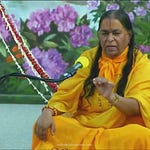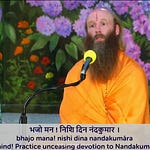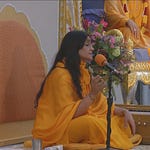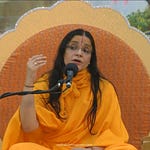Those who reach the state of brahmabhoot avasthā (ब्रह्मभूत: अवस्था) and prasannātmā (प्रसन्नात्मा), they are always happy.
…न शोचति न काङ् क्षति |
…na shochati na kāṅkṣhati.- Gita 12.17
“There is not any desire and that's why there is no cause of any kind of miseries as well.”
Why? Because now they have attained the knowledge of ātmā.
So far we do not have any knowledge, not even one percent knowledge of ātmā. That's why we consider our body as me, as ātmā. And that's why we make many desires for this material world; there's no end to desires. That's why our life is always miserable because there's no limit to our desire. We keep on making desires and our means are very limited. And because we are seeing the bodies (of others), then we think, “He is mine. He is not mine. Oh, he is my son, or he is the son of the other person.” That's why there’s rāg and dwesh - we love someone and we hate someone. All these causes of miseries are there with us. That's why our life is always miserable.
But now in the state of brahmabhoot avasthā they know the ātmā. They have the knowledge of ātmā and they enjoy the bliss of ātmā. They have no time to think about anything else. And because they know ātmā that's why they do not see the bodies of the people. They see ātmā.
And ātmā is alive in all living beings. So that's why there is no love, no attachment, no hatred, no enmity, nothing at all. That's why. And they're not desiring anything else, because they know this world is insipid. This world has no happiness. It is not ‘me’. That's why they are not attached to anything in this world as well.
That's why, “…na shochati na kāṅkṣhati (...न शोचति न काङ् क्षति |) and prasannātmā (प्रसन्नात्मा) .” They are always very happy. They attain big happiness.
They have no idea that there is some happiness beyond it as well. So, if the guru of this type of gyani is not a brahmānandi Guru, a liberated soul, then sometimes they (the disciple) are misled and begin to think, “I am now God realized soul.” And because of this reason they become so egoistic that they lose the benefit of all their knowledge.
But those who know, they know, “I have attained that because of sattvāt sanjāyate gyānam (सत्त्वात्सञ्जायते ज्ञानं). I have gone across sāttvic and rājas māyā but sāttva guṇ is still there. Sāttva and rājas māyā is called swaroop vārikā māyā. We do not know ourselves. We don't know the atma. Why? Because sāttvic and rājas maya is hiding our own self. We don't know about our own self. Why? Because of rājas and tāmas māyā.
But sattva guṇ is there: sattvāt sañjāyate gyānaṁ (सत्त्वात्सञ्जायते ज्ञानं). Sattva guṇ is there. That is when we will cross that guṇ as well. That is guṇavārikā māyā (गुणवारिका माया) - maya of three guṇas. When we cross that as well, then we will be liberated. And after that liberation, after crossing the sattva guṇ māyā as well, crossing the swaroop vārikā māyā as well, one becomes liberated. Now the soul is free from māyā forever and he attains brahm darshan, brahmānand, and attains the knowledge of brahm.









